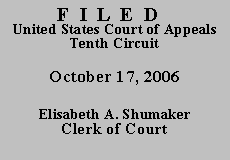

| UNITED STATES OF AMERICA,
Plaintiff-Appellee, Defendant-Appellant. |
No. 06-4050
(D.C. Nos. 2:98-CV-880-DS and 2:95-CR-149-DS) (Utah) |
Mr. Little is currently serving a twelve-year sentence for setting off a pipebomb outside the dormitory room of two African-American students at Dixie College in St. George, Utah. Little was certified as an adult for trial, pursuant to 18 U.S.C. § 5082, based on a prior California juvenile conviction. He was convicted of violating 18 U.S.C. § 844(i) (malicious damage and destruction by fire and explosive); 26 U.S.C. § 5861(d) (possession of an unregistered firearm); and 42 U.S.C. § 3631(a) (interference with housing rights of person on the basis of race). We affirmed the conviction. See United States v. Little, No. 96-4136, 1997 WL 767765 (10th Cir. Dec. 11, 1997).
In 1998, Mr. Little filed his first motion to vacate, set aside or correct his sentence pursuant to 28 U.S.C. § 2255. The district court denied his motion, and Mr. Little appealed. We denied his application for a certificate of appealability ("COA") and dismissed his appeal. See United States v. Little, 43 Fed. Appx. 368, 2002 WL 1881132 (10th Cir., Aug. 16, 2002). Since then, Mr. Little has filed several applications requesting authorization to file successive § 2255 motions, all of which we have dismissed or denied for failure to satisfy the AEDPA criteria. Mr. Little filed the present motion under Fed. R. Civ. P. 60(b)(4), claiming it was not a collateral attack on his conviction and sentence. The district court disagreed, denying the petition and dismissing the underlying claims as unauthorized successive § 2255 claims.
Our review of the record reveals that Mr. Little's Rule 60(b)(4) motion is not a "true" Rule 60(b) motion, but is instead a successive §2255 motion masquerading as a Rule 60(b) motion. See Spitznas v. Boone, __ F.3d __, 2006 WL 2789868 at *1 (10th Cir., Sept. 29, 2006). "[A] 60(b) motion is a second or successive [§ 2255 motion] if it in substance or effect asserts or reasserts a federal basis for relief from the petitioner's underlying conviction" or sentence. Id. Although Mr. Little argues that his motion challenges the district court's ruling on the § 2255 motion he filed in 1998, his argument that he should have been sentenced pursuant to one guideline provision rather than another merely reasserts a federal basis for relief from his underlying sentence. As such, the district court correctly construed his Rule 60(b) motion as a successive § 2255 motion and properly dismissed it for lack of jurisdiction.
Accordingly, we construe Mr. Little's notice of appeal as an application for authorization to file a successive § 2255 motion. "Under the AEDPA, a second or successive § 2255 motion is not permitted to be filed in district court until the 'applicant [moves] in the appropriate court of appeals for an order authorizing the district court to consider the application.' 28 U.S. C. §§ 2244(b)(3)(a) and 2255." Leonard v. United States, 383 F.3d 1146, 1147 (10th Cir. 2004). In order to receive authorization to file a successive petition,
an applicant must make a prima facie showing that he satisfies the criteria in § 2244(b)(2). . . . That is he must show that: (i) the factual predicate for the claim could not have been discovered previously through the exercise of due diligence; and (ii) the facts underlying the claim, if proven and viewed in light of the evidence as a whole, would be sufficient to establish by clear and convincing evidence that, but for constitutional error, no reasonable factfinder would have found the applicant guilty of the underlying offense. See 28 U.S.C. § 2244(b)(2)(B).
Spitznas, 2006 WL 2789868 at *12. We need not consider whether Mr. Little meets the second element of this inquiry, "since the test is conjunctive and he fails the first element." Id. Mr. Little presents no new facts or evidence in support of his claim that he was sentenced improperly.
Based on the foregoing, we GRANT Mr. Little's request to proceed on appeal in forma pauperis, but we DENY Mr. Little's application for authorization to file a successive § 2255 motion and DISMISS his appeal.
ENTERED FOR THE COURT
Stephanie K. Seymour
Circuit Judge
*.This order is not binding precedent, except under the doctrines of law of the case, res judicata, and collateral estoppel.
1. Because he is proceeding pro se, we review Mr. Little's pleadings and filings liberally. See Haines v. Kerner, 404 U.S. 519, 520-21 (1972); Hall v. Bellmon, 935 F.2d 1106, 1110 (10th Cir.1991).
2. Mr. Little also filed an application for a certificate of appealability ("COA"). Ordinarily, a litigant seeking to appeal a district court's denial of his Rule 60(b) motion must obtain a COA. See Spitznas v. Boone, __ F.3d __, 2006 WL 2789868 at *3 (10th Cir., Sept. 29, 2006). However, where, as here, the district court correctly construed the litigant's Rule 60(b) motion as a second or successive § 2255 motion and dismissed it for lack of jurisdiction, the proper avenue for the litigant is to seek authorization from this court to file the successive § 2255 motion, and a COA is not necessary. Id. at *4.